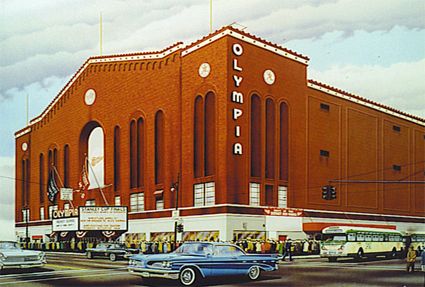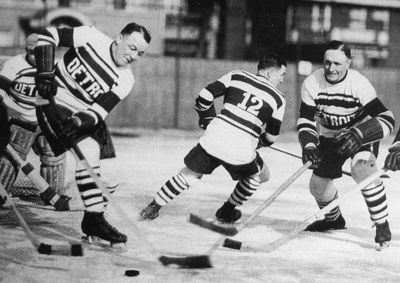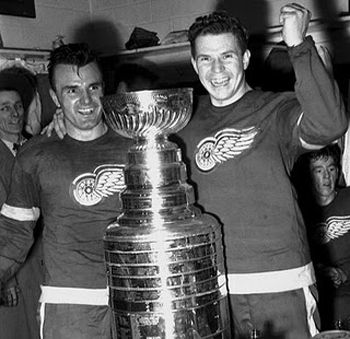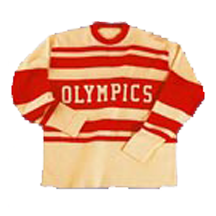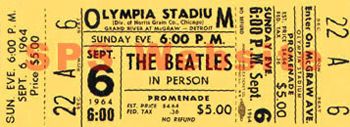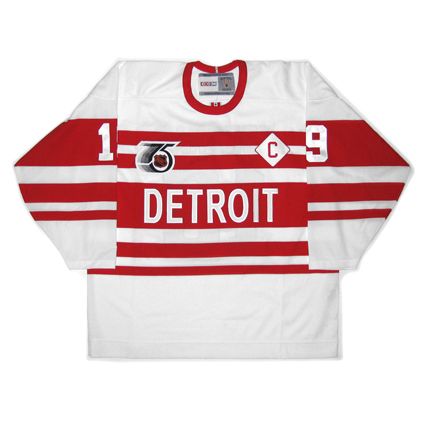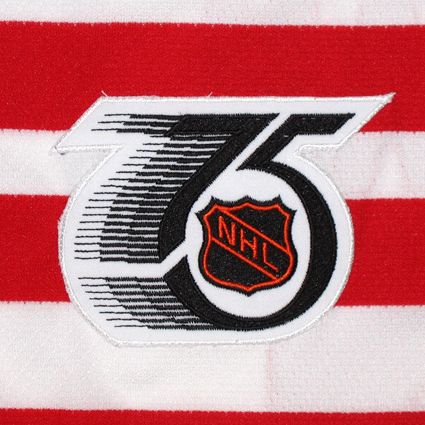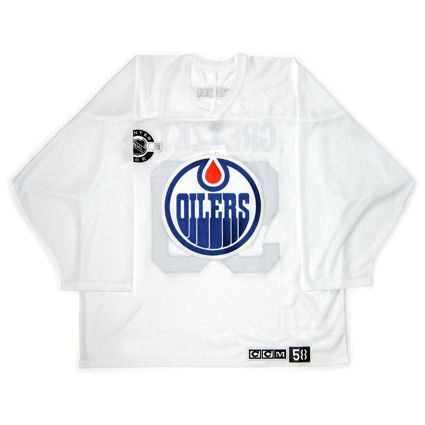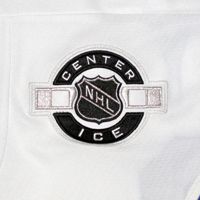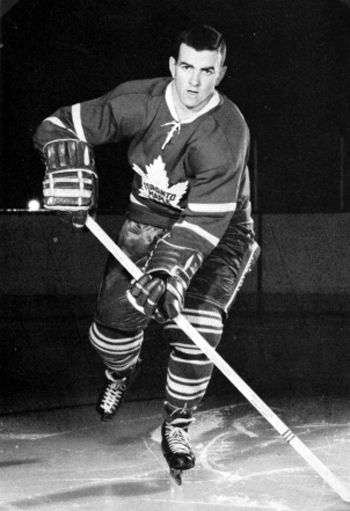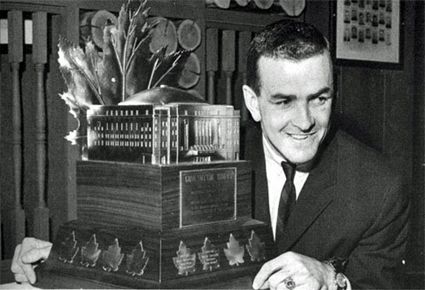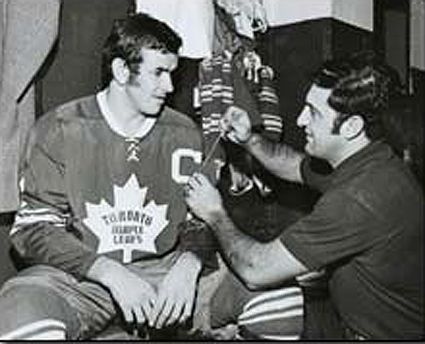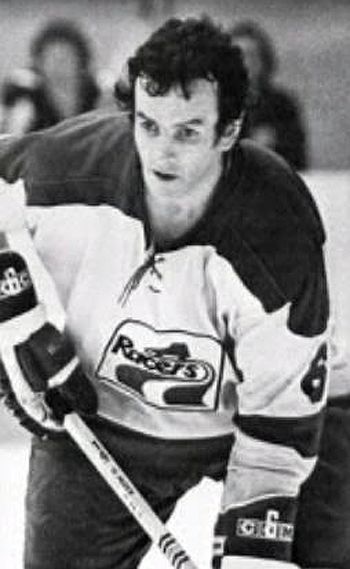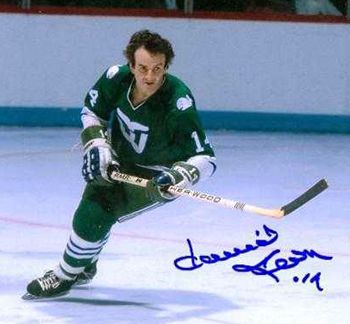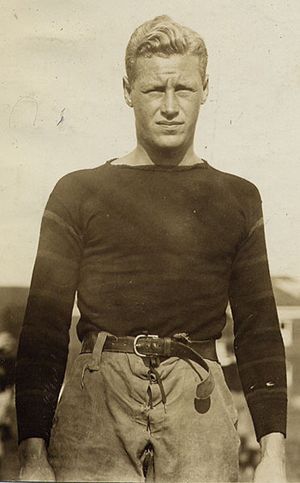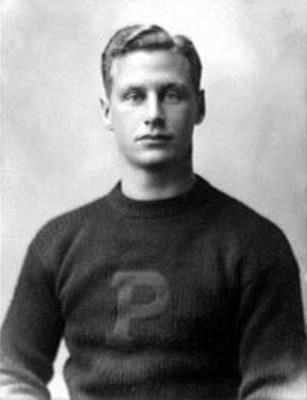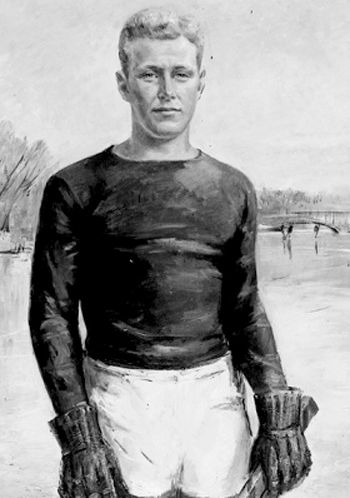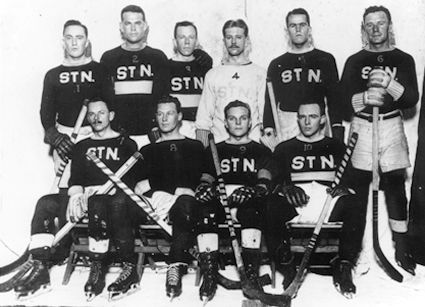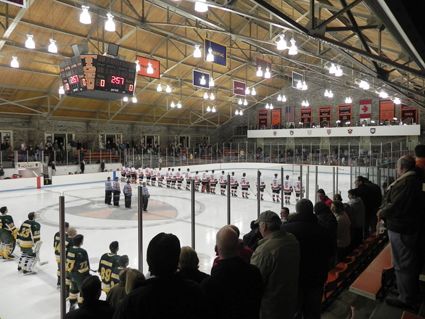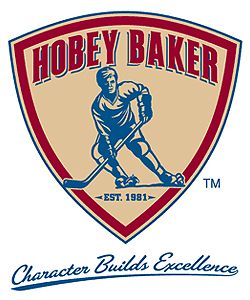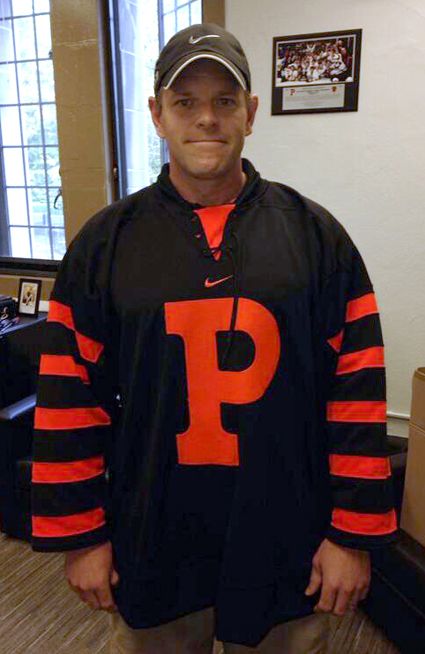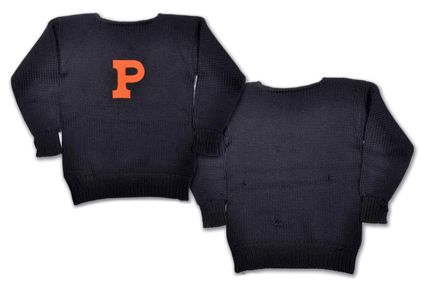Friday, November 22, 2013
1991-92 Detroit Red Wings Steve Yzerman Jersey
On this date in 1927, the Detroit Olympia hosted it's first NHL contest when the Detroit Cougars welcomed the Ottawa Senators in front of a standing room crowd of 14,000 fans as Johnny Sheppard of the Cougars scored the first goal in the history of the arena only to have the Senators come back for a 2-1 win.
The arena was built at a cost of $1.3 million with a seated capacity of 11,563 with room for another 5,000 standing room patrons. The Victoria Cougars of the WHL were purchased by Charles Hughes, a member of the Detroit Athletic Club and played their first season across the Detriot River in Windsor, Ontario prior to moving into the brand new Olympia for the 1927-28 season.
The Cougars would later change their name to first the Falcons in 1930 and then the Red Wings in 1932, but would remain tenants of the Olympia, nicknamed "The Old Red Barn", until December 15, 1979, a span of 52 years. While calling the Olympia home, the Red Wings would win the Stanley Cup seven times in 1936 and 1937, 1943 and, led by "The Production Line" of Sid Abel, Ted Lindsay and Gordie Howe, in 1950 and 1952. Alex Delvecchio replaced Abel in 1952 and the Red Wings would win two more Stanley Cups in 1954 and 1955.
Harry Lumley and Pete Babando celebrate Babando's Game 7 double overtime cup winning goal in 1950 at the Olympia
As defending champions, the Red Wings would host the NHL All-Star Game at the Olympia four times in 1950, 1952, 1954 and 1955.
In addition to the Red Wings, the Detroit Olympics played minor league hockey at the Olympia from 1927 to 1936, which included winning the Calder Cup as champions of the International Hockey League in 1935 and 1936. Despite winning the championship in 1936, the Olympics would move to Pittsburgh the very next season to become the Hornets.
A Detroit Olympics jersey, handed down from the Cougars
The NCAA college hockey Frozen Four was also held near the end of the Olympia's run in 1977 and 1979.
The Detroit Pistons of the NBA spent four seasons at the Olympia which included hosting the NBA All-Star game in 1959.
In addition to hockey and basketball, the Olympia was a major venue for boxing as well as wrestling, ice shows and concerts, which included The Beatles, Elvis Presley, The Rolling Stones and Frank Sanatra.
A ticket from The Beatles 1964 concert at the Olympia. Note the $5 price!
At the end of the Olympia's run as home of the Red Wings, it had become the smallest building in the NHL. Once the Red Wings moved to Joe Louis Arena, the final hockey game at the Olympia was a Red Wings old timers game on February 21, 1980 to commemorate the arena, which was torn down in July of 1986.
Today's featured jersey is a 1991-92 Detroit Red Wings Steve Yzerman jersey. To celebrate the NHL's 75th anniversary, the Original 6 clubs all wore throwback jerseys to mark the occasion, with the Red Wings wearing the jerseys worn by the 1927-28 Detroit Cougars.
After wearing a jersey with an old English "D" on the front for their first season, which was revived for the 2009 Winter Classic, the Cougars changed to the original version of today's featured jersey for their inaugural season in the Olympia of 1927-28. This style lasted only one season before being replaced by a white jersey with a cougar head below the word "Detroit" for one season prior to a return to the 1927-28 template for 1929-30, only now with the word "Detroit" on the front in red outlined in white. The jerseys changed once again for 1930-31 to a similarly designed white jersey with multiple horizontal red stripes with "Detroit Falcons" in yellow outlined in red for two seasons, giving the club two names and five different jerseys in six seasons.
All that would change in 1932 when the team adopted the name "Red Wings" and wore a solid red jersey with simple white stripes around each arm and around the waist, which has remained essentially unchanged for nearly 80 years.
In today's video section, the conclusion of Game 7 of the 1950 Stanley Cup Finals played at the Olympia, the first cup finals to end in sudden death overtime.
Once more the Stanley Cup Finals comes down to Game 7 at the Olympia, where the Red Wings again prevailed, this time in 1955.
As was the case with most major arenas, concerts were also a large part of their history. Here, The Beatles play the Olympia in 1964. This video actually features very good sound, as many old Beatles videos have the music drowned out by the never ending screaming of the fans.
Our final video todays is a melodramatic photo tribute to the Detroit Olympia.
Labels:
Detroit Olympia,
Detroit Red Wings,
Yzerman Steve
Thursday, November 21, 2013
2003-04 Edmonton Oilers Wayne Gretzky Heritage Classic Practice Jersey
Held to commemorate the Edmonton Oilers 25th season in the NHL and the 20th Anniversary of their first Stanley Cup Championship, the Oilers staged the first regular season outdoor game in NHL history, dubbed The Heritage Classic. The game was staged at Commonwealth Stadium, home of the Edmonton Eskimos of the Canadian Football League in front of a capacity crowd of 57,167 fans despite temperatures of 0ºF and a windchill of -22ºF.
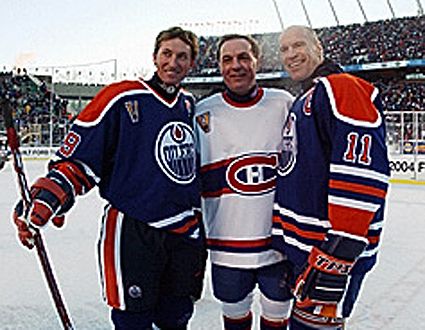
Wayne Gretzky, Guy Lafleur and Mark Messier pose at the MegaStars Game
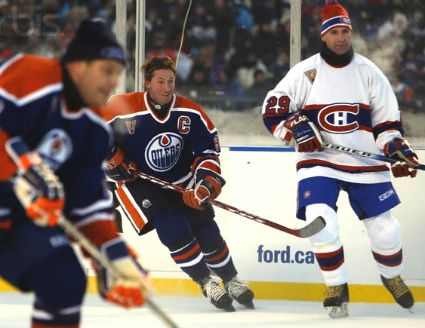




The weekend of events also featured the Heritage Classic MegaStars Alumni Game, which featured past Edmonton Oilers stars from their 1980's dynasty, such as Wayne Gretzky, Paul Coffey, Jari Kurri, Grant Fuhr, Bill Ranford and Glenn Anderson versus Montreal Canadiens greats representing their 1970's dynasty, along with a few players from their 1986 and 1993 Stanley Cup teams, led by Guy Lafleur, Steve Shutt, Guy Lapointe and Larry Robinson. Mark Messier even received permission from the New York Rangers to play in the MegaStars game for the Oilers, the only currently active player to compete in the contest.

Aside from the Oilers first NHL captain Ron Chipperfield and Russ Courtnall for the Canadiens all the players in the contest had won a Stanley Cup for either the Oilers or the Canadiens. Mark Napier held the distinction of being the only player in the game who had won a cup with both the Oilers and Canadiens.
The game was played in two fifteen-minute halves and was won by the Oliers by a score of 2-0 on goals by Ken Linseman and Marty McSorley. Goaltenders Fuhr and Ranford combined for 25 saves in the Oilers goal for the shutout. With his number 31 having been recently retired by the Oilers Fuhr stated "You can't ask for more to happen in one year. I should almost buy a lottery ticket."
The Oilers wore throwback jerseys from their Stanley Cup dynasty, an obvious choice, while the Canadiens wore their vintage jerseys based on their sweaters from their 1946 Stanley Cup championship team, which would later become their third jerseys.

Lafleur stated "It felt like we were 10 again, but with the legs of 50-year-olds."
One of the highlights of the event was the sight of the players shoveling snow off the ice between halves like they did in their youth.

"Everybody is so happy to be involved in this," Messier said. "It's unbelievable o see so many fans come out to see this game."
"The concept was just fantastic," added Lafleur.

The day prior to the MegaStars Game, the teams held a practice to get their legs moving and get used to the outdoor rink.
"The ice was hard, it was great, and I think it will be better (Saturday) after a little bit of use (Friday)," said Messier after the practice.
"It's just amazing to come back and for it to be that easy for everybody - to fit in, to say hello, to get out there and practice. It was just like we left off," added Messier."All the pieces fit comfortably together."
Glenn Sather, who coached the Oilers alumni, said that Friday's practice "was kind of a romantic moment."
Today's featured jersey is a 2002-04 Edmonton Oilers Wayne Gretzky practice jersey as worn during the Friday practice the day prior to the MegaStars Game.


It features Gretzky's name and number on the back as well as the NHL Center Ice logo on the right chest. Other added details is the CCM logo and stenciled "58" size tag on the font hem and the CCM logo just below the collar on the back.
Creating this simple practice jersey was not as easy as one would think, as all the separate elements were added individually to the jersey. A blank, white jersey was first purchased, along with a "donor" black Pittsburgh Penguins jersey for the Center Ice and CCM logos since a white Oilers jersey of this vintage was not available. Once the three logos was transferred over from the Penguins jersey, an Oilers crest, purchased separately on ebay was added to the jersey.
The size "58" tag was then made with our custom printing technique for added detail and finally the jersey was customized with Gretkzy's name an number in one color blue as worn during the practice to complete the project.
Here is an interesting interview with Gretzky about his participation in the MegaStars Game and his reluctance to participate in Old Timers Games, as well as his enlightened prediction that the Winter Classic would follow in the Heritage Classic's footsteps.
Next is a great video find, footage from the Friday practice session where today's featured jersey was worn as well as interviews with the players involved.
Here Wayne reflects on his favorite moment of the Heritage Classic, the Friday practice that today's featured jersey is from.
Wednesday, November 20, 2013
1966-67 Toronto Maple Leafs Dave Keon Jersey
On this date in 1974, Dave Keon of the Toronto Maple Leafs played in his 1,000th career game, and celebrated the occasion in style by scoring a hat trick, the fifth of his career.


Keon joined the Maple Leafs for the 1960-61 season and won the Calder Trophy following a 20 goal, 45 point campaign. He would go to have five more consecutive 20-goals seasons.
During Keon's second season in the NHL, in which the Maple Leafs would capture the Stanley Cup, Keon would add the Lady Byng Memorial Trophy to his already growing trophy case after a season in which he drew but a single minor penalty in 64 games played.
He was one of the fastest skaters in the NHL and one of the best defensive forwards as well, often being matched up against the opposition's top centers.
More Stanley Cups would follow in 1963, as well as a second Lady Byng Trophy, and again in 1964, a season in which Keon would lead the Maple Leafs in scoring for the first time.
After leading the Maple Leafs in scoring again in 1966-67, the Maple Leafs would win the Stanley Cup as Keon was named the Conn Smythe Trophy winner, the only Maple Leaf to ever win the trophy named for the former owner of the club.
Keon was named captain of the Maple Leafs in 1969-70 and led the team in scoring yet again before setting a then NHL record in 1970-71 with eight shorthanded goals.
Keon has the captain's "C" sewn on to his jersey by Maple Leafs trainer Joe Sgro, while still wearing his jersey!
After coming to an agreement to join the Ottawa Nationals of the fledgling WHA in 1972, the deal fell apart and Keon signed a three year contract to remain in Toronto and led the team in goal scoring in 1972-73, which included his 297th goal as a Maple Leaf, passing George Armstrong and Frank Mahavolich as the franchise's all-time leading goal scorer.
Having fallen out of favor with Maple Leaf's owner Harold Ballard by the end of his contract, Keon jumped to the rival WHA and signed with the Minnesota Fighting Saints. When the Fighting Saints folded, Keon was unable to return to the NHL because the Maple Leafs still held his NHL rights and owner Ballard wanted too steep a level of compensation from any NHL club signing him, effectively locking Keon out of the NHL.
With only the WHA as an option, Keon signed with the Indianapolis Racers for the remainder of the season. He was traded to the new incarnation of the Minnesota Fighting Saints for the following season, only to see that version of the franchise again fold during before the completion of the season.
He once more found some stability when he joined the WHA's New England Whalers, where he would play for the remainder of his career, three seasons in the WHA and three more finally back in the NHL following the merger in 1979.
Indianapolis Racer Dave Keon
He once more found some stability when he joined the WHA's New England Whalers, where he would play for the remainder of his career, three seasons in the WHA and three more finally back in the NHL following the merger in 1979.
It was during the 1979-80 season that Keon, then 40 years old, was occasionally on a line with both Gordie Howe (age 50) and Bobby Hull (age 41). When both Howe and Hull retired, Keon was the oldest player in the NHL for his final two seasons before retiring after the 1981-82 season at age 42.
Keon's final totals were 396 goals and 590 assists for 986 NHL points and another 102 goals and 189 assists for 291 points in the WHA, the Calder Trophy, two Lady Byng Trophies, a Conn Smythe Trophy, eight NHL All-Star Game appearances and four Stanley Cups as well as being inducted into the Hockey Hall of Fame in 1986.
Today's featured jersey is a 1966-67 Toronto Maple Leafs Dave Keon jersey as worn during the fourth Stanley Cup season of Keon's career. The jersey features the tie-neck collar and assistant captain's A Keon would wear before being named the 12th Captain in Maple Leafs history. No names were worn on the back of Maple Leafs jerseys during that era.
There is a great story about Maple Leafs owner Harold Ballard that recalls when the league made it mandatory in 1978 to put players names on the backs of their home and away jerseys, the notoriously cantankerous Ballard refused to do so, claiming sales of programs would be reduced and probably in part because he never liked being told by the league, and then NHL President John Ziegler in particular, what to do. When finally forced to comply by the league after being fined, Ballard fought back on February 26, 1978 by putting the names on the back of their blue road jerseys for a game in Chicago in the same blue color as the jersey, making them impossible to read!


Today's first video is Dave Keon's "Legends of Hockey" biography.
This video is from the 1970-71 season, the Maple Leafs first with their new jerseys and new, modern logo, which is still in use today. Keon scores early in the video on a really nice deke against the Detroit Red Wings. After Keon's goal, the Maple Leafs start picking off fans in the stands with flying pucks, as they nail two in a row!
Here are the final minutes of the Maple Leafs last Stanley Cup championship, won while wearing today's featured jersey.
This piece of sheer brilliance was too good to pass up, the Maple Leafs Top Ten Highest Scorers Named Dave!
Finally, a tour of the Dave Keon Arena in Rouyn Noranda, Quebec.
Labels:
Keon Dave,
Toronto Maple Leafs
Monday, November 18, 2013
2013-14 Princeton University Tigers "Hobey Baker" Jersey
Hobart Amory Hare "Hobey" Baker was considered he first American star hockey player. He hailed from Philadelphia and enrolled at Princeton University in 1910, where he played for both the Tigers' hockey and football teams. He was considered one of the best athletes of his time, showing immediate skill in hockey, football, golf, baseball, tennis swimming and track.
While at Princeton, Baker would win a national championship in 1911 as a halfback with the football team and in 1912 and 1914 with the hockey team, where he was known as a fast and agile skater.
Sportswriters in Philadelphia referred to him as "the blond Adonis of the gridiron", thanks in part to the fact he played football without a helmet! Baker set a school record with 92 points in 1911, a record which stood for 63 years. In 1913 he was named captain of the team for his senior year.
While statistics were not kept during Baker's time with the Tigers, it's been estimated that he scored over 120 goals and 100 assists in three years, an average of nearly 4.5 goals per game and more than 3 assists per game. Aside from his offensive skills, he was also well known for his sportsmanship and gentlemanly play, being called for only a single penalty during his entire college career and known for visiting the opponents dressing room after every game to shake hands with each player.
He concluded his football career at Princeton with a 20-3-4 record and his hockey career with a 20-7 mark.
After graduating in 1914, Baker would win a national amateur championship with the St. Nicholas Hockey Club in 1915. So well known was Baker by this point that the marquee at the arena would read "Hobey Baker plays tonight." While with the St. Nicholas club, Baker turned down a $20,000 offer to play for the Montreal Canadiens, as it was frowned up at the time to for someone of his stature in society to play sports for money.
Following his graduation from Princeton, Baker worked for a time in New York and took up aviation as a hobby during this time period, including once leading a squadron of a dozen planes over the Princeton football stadium before landing his plane on the football field!
He then enlisted in the United States Army Air Service. While serving in Europe during World War I, Baker rose to the level of captain and was named commander of the 141st Aero Squadron, where he had the planes painted in Princeton's black and orange and adopted a tiger as the squadron logo.
In 1918, Baker was test piloting a recently repaired plane, it crashed, killing him hours before he was due to leave France and return to the United States.
Baker was so highly regarded that he was the only American in the Hockey Hall of Fame's inaugural class of nine inductees in 1945 and one of the first group of inductees into the United States Hockey Hall of Fame in 1973. Two years later, Baker was inducted into the College Football Hall of Fame, the only person to be inducted into the Hockey and College Football Halls of Fame.
In 1921, Princeton named it's new arena the Hobey Baker Memorial Rink, still used by the Tigers and currently the second oldest arena in American college hockey.
1980 would see the NCAA introduce the Hobey Baker Award, given annually to the nation's best college hockey player.
This past Saturday against ECAC and Ivy League rival Harvard, the Tigers wore special throwback jerseys to commemorate the 100th anniversary of Baker, the school's greatest player, and his final season playing at Princeton.
Today's featured jersey is a 2013-14 Princeton University Tigers "Hobey Baker" jersey as modeled by Princeton head coach Bob Prier when the jersey was unveiled back in October.
This jersey is a blend of various styles of jerseys worn by Princeton during Baker's era, as some hockey and football jerseys had the tiger striping down the arms and others the "P" crest on the front, both of which are combined into this highly attractive and effective throwback.
Bonus jersey: Today's bonus jersey is a 1911-12 Princeton University Hobey Baker jersey. This wool sweater is identical to the ones worn by the Tigers during team photos in 1912 and 1914, with it's orange P logo on the chest. It differs from the university's football jerseys of the day, which had v-neck collars, as the hockey team used round neck collars, a lesson in paying attention to details when trying to authenticating jerseys, or in this case, a sweater.
Today's video is about Hobey Baker and the Hobey Baker Award.
While at Princeton, Baker would win a national championship in 1911 as a halfback with the football team and in 1912 and 1914 with the hockey team, where he was known as a fast and agile skater.
The 1912 Princeton championship hockey team
Sportswriters in Philadelphia referred to him as "the blond Adonis of the gridiron", thanks in part to the fact he played football without a helmet! Baker set a school record with 92 points in 1911, a record which stood for 63 years. In 1913 he was named captain of the team for his senior year.
Baker in his Princeton football uniform
While statistics were not kept during Baker's time with the Tigers, it's been estimated that he scored over 120 goals and 100 assists in three years, an average of nearly 4.5 goals per game and more than 3 assists per game. Aside from his offensive skills, he was also well known for his sportsmanship and gentlemanly play, being called for only a single penalty during his entire college career and known for visiting the opponents dressing room after every game to shake hands with each player.
Hobey Baker
He concluded his football career at Princeton with a 20-3-4 record and his hockey career with a 20-7 mark.
Baker on the ice
After graduating in 1914, Baker would win a national amateur championship with the St. Nicholas Hockey Club in 1915. So well known was Baker by this point that the marquee at the arena would read "Hobey Baker plays tonight." While with the St. Nicholas club, Baker turned down a $20,000 offer to play for the Montreal Canadiens, as it was frowned up at the time to for someone of his stature in society to play sports for money.
The St. Nicholas hockey club
Following his graduation from Princeton, Baker worked for a time in New York and took up aviation as a hobby during this time period, including once leading a squadron of a dozen planes over the Princeton football stadium before landing his plane on the football field!
He then enlisted in the United States Army Air Service. While serving in Europe during World War I, Baker rose to the level of captain and was named commander of the 141st Aero Squadron, where he had the planes painted in Princeton's black and orange and adopted a tiger as the squadron logo.
In 1918, Baker was test piloting a recently repaired plane, it crashed, killing him hours before he was due to leave France and return to the United States.
Baker was so highly regarded that he was the only American in the Hockey Hall of Fame's inaugural class of nine inductees in 1945 and one of the first group of inductees into the United States Hockey Hall of Fame in 1973. Two years later, Baker was inducted into the College Football Hall of Fame, the only person to be inducted into the Hockey and College Football Halls of Fame.
In 1921, Princeton named it's new arena the Hobey Baker Memorial Rink, still used by the Tigers and currently the second oldest arena in American college hockey.
Princeton's Hobey Baker Memorial Rink
1980 would see the NCAA introduce the Hobey Baker Award, given annually to the nation's best college hockey player.
This past Saturday against ECAC and Ivy League rival Harvard, the Tigers wore special throwback jerseys to commemorate the 100th anniversary of Baker, the school's greatest player, and his final season playing at Princeton.
Today's featured jersey is a 2013-14 Princeton University Tigers "Hobey Baker" jersey as modeled by Princeton head coach Bob Prier when the jersey was unveiled back in October.
This jersey is a blend of various styles of jerseys worn by Princeton during Baker's era, as some hockey and football jerseys had the tiger striping down the arms and others the "P" crest on the front, both of which are combined into this highly attractive and effective throwback.
Bonus jersey: Today's bonus jersey is a 1911-12 Princeton University Hobey Baker jersey. This wool sweater is identical to the ones worn by the Tigers during team photos in 1912 and 1914, with it's orange P logo on the chest. It differs from the university's football jerseys of the day, which had v-neck collars, as the hockey team used round neck collars, a lesson in paying attention to details when trying to authenticating jerseys, or in this case, a sweater.
Today's video is about Hobey Baker and the Hobey Baker Award.
Labels:
Baker Hobey,
Princeton University
Subscribe to:
Comments (Atom)

